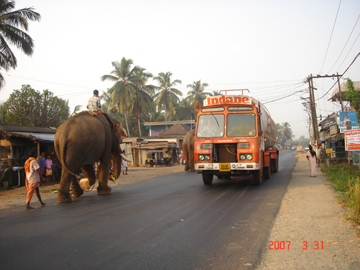Gentle Giants?????
-Shivani Thakur
Elephants have been around man much earlier than the Sangam period i.e. third to fifth centuries AD. Their fossil remains are still found in different parts of India.
They are generally viewed as wise, gentle and reliable. There are about 28,000 elephants left in the wild and around
3500 in captivity. These giants are mainly found in Assam, Kerala, Tamil Nadu, Karnataka, Bihar, Uttar Pradesh and West Bengal.
But these giants are in focus again, but not for their poaching deaths but for causing loss of life and property during the annual festive season in Kerala. Although they were the earliest to be protected by law in 1879, it was in 1992 that Project Elephant
was set up by the government of India due to their decreasing count. They are also categorised under Schedule I of the Wildlife Act.
Therefore it is illegal for anyone to keep an elephant without the permission of State Chief Wildlife Warden.

In the wild these beasts are facing a challenging situation .The increasing pressure on their habitat by ever growing human population and deaths due to accidents caused by trains moving through the sanctuaries. Farmers find them a nuisance as they spoil
their season’s crops. But a large scale decline in the wild population is due to poachers. Unlike their African counterpart, where both male and female have tusks; it is only the male Indian elephant which has tusks. The poachers, by killing bulls,
create a disparity in their numbers.
If wild elephants have it tough then the captive ones are in no better condition.
Unlike other domesticated animals it is highly expensive to keep an elephant. In captivity they are used for by private owners, zoos, temples, and circuses and for logging. Earlier elephants were used extensively for logging of timber in areas inaccessible
by vehicles. But with the ban on logging in the north east and other parts of the country their use has come down dramatically. In Rajasthan, elephant rides at Jaipur’s Amber Fort were part of tourist attractions.
But the pathetic conditions in which they had to work made Rajasthan government put a ban on these rides. The parchyderms were made to stand in the sun without adequate water, walk long distances on metal roads. A report by Geeta Seshmani of Wildlife
SOS indicated that they were suffering from rope soars, sun- burn and footpad wounds.
An adult bull needs a minimum of 275 kgs food and 250 lts of water everyday. Therefore it is difficult for many to maintain captive elephants
who see them as money spinners. In Kerala too the picture is not that rosy. Recently a mahout was killed by an outraged bull during the annual festive season. For decades the elephants and human have co-existed peacefully but the last decade the attack
on humans have increased. The elephant lovers, vets and others agree that the provocation for elephant violence
is invariably from the humans. They are beaten, chained starved and made to work without sufficient rest, food and nourishment. Also the earlier mahouts knew everything about their elephants, treatments, diets or emotions. But
modern day ones see them as money making machines who during festive season can fetch up to
Rs 50,000 for an appearance fee at a temple.
To keep their numbers from decreasing lot of work needs to be done. More elephant corridors need to be built so as to encourage free movement for them in the sanctuaries. Elephants migrate to areas spread across vast regions. Combining one or two reserved
forest would give them the freedom as well as restrain them from entering human habitations. For captive ones an example of Myanmar should be followed where a compulsory use in certain areas of timber operation should be allowed. Similarly vets to keep a check
on all privately owned elephants across the country and mahouts to be trained for their upkeep. And also proper enforcement of law to keep a check on them. But until this is done more tragedies like the one in Kerala will occur and
cordial relations between the beast and man will be destroyed forever.
( Photo: Elephant on a Kerala road by Susan Sharma)
Worried about the future of Asian Elephants? See the film "Wilderness Nepal". View a clip from the film at
http://www.youtube.com/watch?v=uvRbbHzS4bI